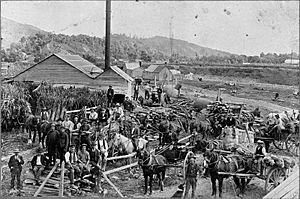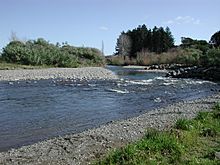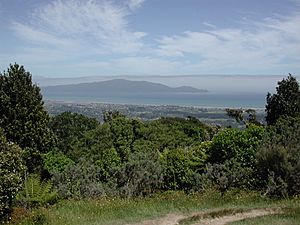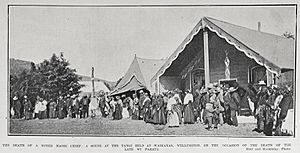Waikanae facts for kids
Quick facts for kids
Waikanae
|
|
|---|---|
|
Medium urban area
|
|

Kapiti Island seen from Waikanae Beach
|
|
| Country | New Zealand |
| Region | Wellington Region |
| Territorial authority | Kapiti Coast District |
| Ward | Waikanae Ward |
| Area | |
| • Total | 29.61 km2 (11.43 sq mi) |
| Population
(June 2023)
|
|
| • Total | 13,150 |
| • Density | 444.11/km2 (1,150.2/sq mi) |
Waikanae is a town on New Zealand's Kapiti Coast. The name is a Māori word meaning "waters" (wai) "of the grey mullet".
The town lies about 60 kilometres north of Wellington: New Zealand's capital city; between Paraparaumu, eight kilometres to the southwest, and Ōtaki, 15 kilometres to the northeast.
Another settlement called Waikanae Beach exists near Gisborne on the east coast of the North Island of New Zealand.
Contents
Geography
Waikanae lies in a setting of open farmland and forest between the Tasman Sea and the rugged Tararua Ranges. Together with its neighbouring settlement of Waikanae Beach, the township comprises a quiet locale, popular with families and retirees. Just north of Waikanae is the small community of Peka Peka.
The area surrounding the township is notable for its 5-kilometre long beach and its wide river mouth opposite Kapiti Island, which lies four kilometres offshore in the Tasman Sea. The Kapiti Island Nature Reserve includes the Waikanae Estuary Scientific Reserve. The Te Araroa Trail leads through Waikanae.
The waters between Waikanae Beach and Kapiti Island comprise the Kapiti Marine Reserve, with whales and Hector's dolphins sometimes spotted on their migration routes through the narrow corridor. Inland, behind Waikanae, are the bush clad Hemi Matenga Reserve, the Tararua Ranges and the Akatarawa Valley, home to a popular conservation park, Staglands Wildlife Reserve. A road through the valley over the Akatarawa Saddle provides a link with the Hutt Valley via Reikorangi and Cloustonville. The headwaters of the Waikanae River form where a number of streams converge in the inland Reikorangi Basin. From here the river runs through a gap in the foothills, across the coastal plain and sand dunes to the sea.
Prior to human settlement the Waikanae coastal plain comprised wetlands divided by a complex pattern of natural waterways and kohekohe wooded regions. Wetlands remain a diminishing feature of the region but the development of numerous private gardens has led to Waikanae having one of the highest levels of water consumption per head of population in New Zealand. The community draws its water from the single source of the Waikanae River, and seasonal shortages during the warmer months of the year constitute a growing problem for the township.
Birdlife
Waikanae Beach is populated by terns, seagulls, oystercatchers, and stilts. Inland wetlands provide refuge for pukeko, crake and New Zealand dabchicks. White fronted herons and shags range across the coastal plain. The ready availability of both birdlife and seafood encouraged early Māori settlement of the area. Introduced species such as ducks and black swans have also flourished over the last century.
Hemi Matenga Memorial Scenic Reserve
Waikanae is backed by the heavily forested 330-hectare Hemi Matenga Reserve covering a range overlooking the township. Rising to 514 metres above sea level, the forest comprises one of the most extensive areas of kohekohe woodland left in New Zealand. The reserve is named after its former owner; Hemi Matenga Waipunahau of the Ngati Toa. It is traversed by several walking tracks and forms an extension of the Tararua Range.
History
Archaeological and ethnographical research suggests that Waikanae may have been first inhabited by the Waitaha moa-hunters as early as a thousand years ago. Successive waves of settlement by the Ngati Apa, Rangitane and Muaupoko tribal groups ensured that the area continues to have major historic and mythological significance for the Māori people of New Zealand. See Kapiti Coast for greater detail.
Population
The 2013 New Zealand Census records the usually-resident population of Waikanae and Waikanae Beach combined as 10,630. It is forecast that Waikanae's relative abundance of unoccupied land and recent or pending improvements in transport links will lead to a population increase to about 15,000 by 2032. The most recent census with fully published returns (2006) records that 35% of Waikanae's population were 65 years-of-age or older, many of them living in retirement villages (grouped housing units in garden settings).
Facilities
The central Waikanae Village includes two supermarkets, the Mahara Art Gallery, three bank branches, a health centre, two pharmacies, craft and art shops, a post shop, a war memorial hall, a smaller community hall, a small museum, church, library, cinema and a number of other shops and restaurants. Nearby are the Nga Manu Nature Reserve, two primary schools, a golf course, bowling club, Waikanae Park cricket ground and several retirement centres.
Climate
The Tararua Range provides shelter for Waikanae from the south and east, as does Kapiti Island from the west. The area accordingly escapes the heavy winds and storms of the neighboring Cook Strait region. The shallow depths of Waikanae Beach produces a higher water temperature than the steeper coastlines of Wellington harbour to the south. The prevailing wind blows from the north-west, which drives rain-clouds inland to the ranges and results in high rainfalls during the winter and spring.
Transport

The town is located on State Highway 1 and the North Island Main Trunk railway. In February 2017 an expressway diversion was opened to enable State Highway 1 to bypass the centre of the township.
The town is the current northern terminus of the Kapiti Line for the Metlink commuter rail service. This service has operated since February 2011, into the newly rebuilt Waikanae Railway Station. The new Matangi electric multiple units entered service at the same time in 2011. Prior to that, the only direct commuter train to Wellington was the Capital Connection from Palmerston North which still leaves for Wellington in the morning and returns in the evening en route to Palmerston North.
Local bus services link Waikanae Village with Waikanae Beach and Otaki.
Demographics
Waikanae is defined by Statistics New Zealand as a medium urban area and covers 29.61 km2 (11.43 sq mi). It had an estimated population of 13,150 as of June 2023, with a population density of 443.96 people per km2.
| Historical population | ||
|---|---|---|
| Year | Pop. | ±% p.a. |
| 2006 | 10,563 | — |
| 2013 | 11,106 | +0.72% |
| 2018 | 12,711 | +2.74% |
Waikanae had a population of 12,711 at the 2018 New Zealand census, an increase of 1,605 people (14.5%) since the 2013 census, and an increase of 2,148 people (20.3%) since the 2006 census. There were 5,460 households. There were 5,853 males and 6,858 females, giving a sex ratio of 0.85 males per female, with 1,881 people (14.8%) aged under 15 years, 1,344 (10.6%) aged 15 to 29, 4,845 (38.1%) aged 30 to 64, and 4,632 (36.4%) aged 65 or older.
Ethnicities were 90.9% European/Pākehā, 9.2% Māori, 2.1% Pacific peoples, 4.5% Asian, and 2.0% other ethnicities (totals add to more than 100% since people could identify with multiple ethnicities).
The proportion of people born overseas was 24.9%, compared with 27.1% nationally.
Although some people objected to giving their religion, 48.8% had no religion, 41.3% were Christian, 0.4% were Hindu, 0.2% were Muslim, 0.5% were Buddhist and 2.1% had other religions.
Of those at least 15 years old, 2,766 (25.5%) people had a bachelor or higher degree, and 1,635 (15.1%) people had no formal qualifications. The employment status of those at least 15 was that 4,011 (37.0%) people were employed full-time, 1,482 (13.7%) were part-time, and 279 (2.6%) were unemployed.
| Name | Population | Households | Median age | Median income |
|---|---|---|---|---|
| Waikanae Beach | 3,249 | 1,386 | 49.6 years | $36,200 |
| Peka Peka | 612 | 246 | 52.1 years | $42,500 |
| Waikanae Park | 2,085 | 900 | 58 years | $30,300 |
| Waikanae West | 4,374 | 1,968 | 61.8 years | $26,600 |
| Waikanae East | 2,391 | 960 | 51.2 years | $30,200 |
| New Zealand | 37.4 years | $31,800 |
It is forecast that Waikanae's relative abundance of unoccupied land and recent or pending improvements in transport links will lead to a population increase to about 15,000 by 2032.
Education
Waikanae School is a co-educational state primary school for Year 1 to 8 students, with a roll of 540 as of April 2023.
Kapakapanui School is also a co-educational state primary school for Year 1 to 8 students, with a roll of 539.
Notable people
- Erunui Matioro Te Tupe-o-Tu: retired to Waikanae after a colourful life as a tribal leader, warrior, whaler, slaver, and sealer; during the early colonial period from the 1820s to the 1850s.
- Jim Bolger, former New Zealand Prime Minister, currently lives in Waikanae.
Images for kids





